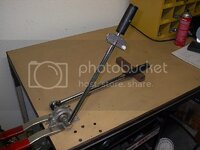69427
The Artist formerly known as Turbo84
My new block and rotating assembly is supposed to be from the machinist this week, and I'll be putting it together soon, and I was concerned about my torque wrench accuracy. I may entertain buying a new one, but I'd like to make sure that's even necessary. I currently have a Craftsman click type wrench, along with a couple bending beam type wrenches. I'm not sure how to check these out for accuracy. Suggestions?
I was entertaining making a (balanced) fixture with a pivot and a (weighted) moment arm to produce a ft.-lb load, but I don't have an accurate way to weigh out the mass that I would attach to the moment arm. The pivot point would have a hex shape to allow putting a socket on it, along with the torque wrench. Pulling on the torque wrench would lift the moment arm weight off its resting point. Too much work?
Like I said, just looking for suggestions here.
Thanks,
Mike
I was entertaining making a (balanced) fixture with a pivot and a (weighted) moment arm to produce a ft.-lb load, but I don't have an accurate way to weigh out the mass that I would attach to the moment arm. The pivot point would have a hex shape to allow putting a socket on it, along with the torque wrench. Pulling on the torque wrench would lift the moment arm weight off its resting point. Too much work?
Like I said, just looking for suggestions here.
Thanks,
Mike

